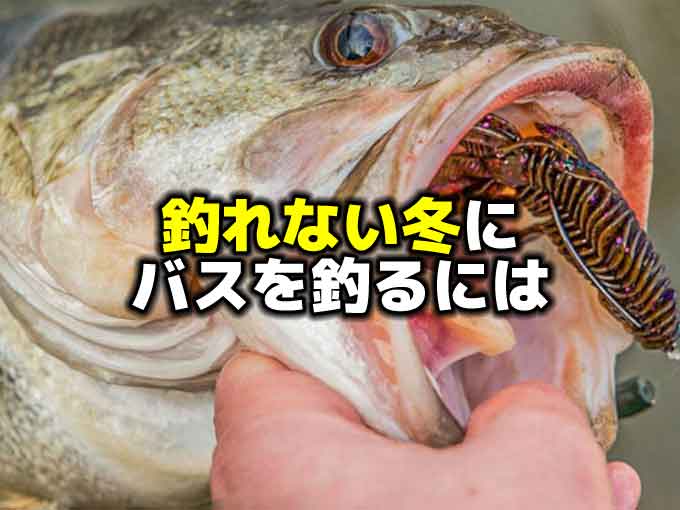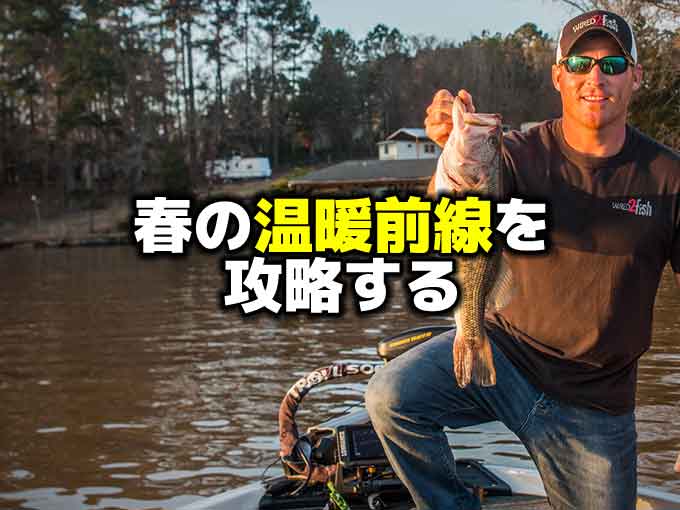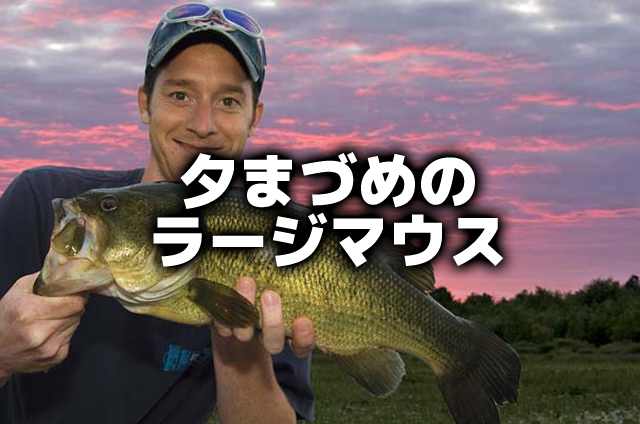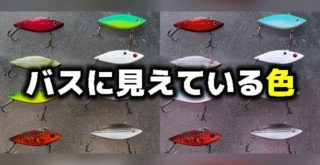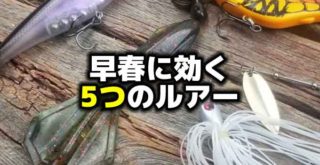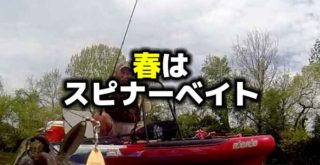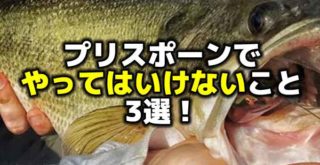冬のジャークベイトでバスを釣るには「決めつけないこと」

Photo by wired2fish.com
こんにちは!店長の小山です!
本日は海外サイトより、”Jerkbait Lessons: Keep an Open Mind this Winter”という記事を引用してご紹介いたします。
引用先:wired2fish.com ”Jerkbait Lessons: Keep an Open Mind this Winter”By Luke Stoner •Jan 28, 2019
ジャークベイトの釣り、皆さんはお好きでしょうか。
冬になると出番が多くなるとされているサスペンドジャークベイトですが、個人的には実際は1年中よく釣れるルアーではないかと思っています。
冬に出番が多くなるのはポーズの時間を長くとれるルアーが有効になるためで、サスペンドジャークベイトが冬のルアーというよりは、どちらかと言えば他に有効なルアーが減ってしまうという意味になるのだと思います。
私はジャークベイトを1年を通してよく投げていて、釣れる魚の数も他のハードルアーに比べて多い方です。自分の中では得意なルアーのひとつという感じです。
しかしたかが自分のレベルの話であっても、得意と言えるようになるまでには時間がかかりました。
色んなジャークベイトやいろんなアクション、リズムを変え続け、ある時ヒットが連発した時に、「あ、なんかわかった気がする」という感じになり、それ以降はなんとなくよく釣れるようなになり、どんどん好きになっていったルアーのひとつです。
私の説明はこんな「なんとなく」な感覚になってしまってすみません(笑)
この記事は、アメリカのバスフィッシング専門メディア「Wired 2 Fish」の記事で、記者のルーク・ストーナー氏が、バスプロに取材した冬のサスペンドジャークベイトのことについてまとめてくれています。
プロの分かりやすい説明を聞いて、なんとなくじゃなしに、きっちり上手になりたいですね。
それでは読んでみることにしましょう。
リズムを変えていく
A jerkbait slowly twitched through the water is a terrific imitation of an injured or dying shad, especially in cold-water scenarios when shad die-offs are common. Figuring out a jerkbait bite can be tricky, but in my opinion, it all starts with fine-tuning the cadence. Cadence is a musical term essentially referring to rhythm, but bass anglers use it to describe the movement we give lures on the retrieve. Think of cadence as the rhythm or beat we follow when twitching (dancing) a lure back to the boat. The tricky part – there is no such thing as the best, or “the right" cadence.
Sometimes the bass seem to want a jerkbait paused for painfully long periods of time between twitches. Then there are days when bass are best fooled by a jerkbait moved quickly, even in winter. Many anglers, myself included, have a bad habit of retrieving a jerkbait with the same or similar cadence throughout a day of fishing. It’s easy to get caught in a rut, even though “jerk-jerk-pause" isn’t cutting it.
Bass fishing superstar and cold-water specialist Mike Iaconelli preaches it is important to experiment with different cadences or retrieves when jerkbait fishing.
“I try to change my cadence every 15 to 20 casts with a jerkbait until I get a bite," Iaconelli said. “Varying your retrieve is always important with a jerkbait, but especially when the water temperatures are in the mid 30s to the mid 50s. I alter the length of my pauses but I also change my rod tip movement and how hard I jerk the bait. These little changes dramatically affect the action of your lure underwater."
Iaconelli’s performance at the 2013 Bassmaster Classic on Grand Lake provides a perfect case study on why experimenting with cadence is imperative. During the first day of practice for the event, Iaconelli recalls he never had a single bite on a jerkbait, even though the conditions set up perfectly for it.
Slightly frustrated, Iaconelli tried using smaller, softer twitches when moving his jerkbait on day 2 of practice. Almost immediately, he caught a bass. By being less aggressive with his cadence, Iaconelli was able to run around Grand Lake and uncover a jerkbait pattern that ultimately led to a 4th place finish. Meanwhile, on the same body of water in the same exact tournament, Kevin VanDam notched a top 10 finish by vigorously snapping his Strike King jerkbaits. Moral of the story, there is no magic jerkbait cadence for bass fishing.
“I don’t allow myself to have a go-to cadence because I want to fish the moment every time I’m on the water," Iaconelli offered. “As a general rule of thumb, the colder the water temps, the longer I let the bait pause in between twitches and the softer I jerk the bait with my rod tip. In contrast, in warmer water I move the bait quicker and more forcefully. The cadence I use changes on every body of water I fish, even throughout the day based on the conditions!"
Alternate the cadence and movement of your lure until you get the first bite. Pay attention to how the bass was hooked and then do your best to replicate that action on the next cast.
特にシャッドキルウェザーと呼ばれるほどの低水温になった状況下において、サスペンドジャークベイトをトゥイッチしながらゆっくりと水中を通していくのは、傷ついた、または死にかけのシャッド(ベイトフィッシュ)を見事に模倣することになります。ジャークベイトでもバイトを得るには難しいのでしょうけども、私の意見では、それはすべてリズムを調節することから始まります。リズムというのは基本的には音楽用語ですが、バスアングラーがこのルアーの動きを説明するのにも使われます。リズムとは、私たちが言うところのルアーをボートまで回収する時のトゥイッチのリズム、もしくはビートだと考えてください。間違えてはいけないのは、最高のリズム、または正しいリズムというものは無いということです。
時としてバスはトゥイッチとトゥイッチの間に結構なロングポーズを入れることを望むようです。あるいは冬であっても、素早いジャークベイトの動きにバスが最も反応するという日もあります。私自身も含めて、多くのアングラーは1日を通して同じまたは似たようなリズムでアクションさせてしまうという悪い習慣を持っています。たとえ 「ジャーク・ジャーク・ポーズ」のリズムがうまくハマっていないと分かっていても、ついついそればかりやってしまいます。
バスフィッシング界のスーパースターであり低水温のスペシャリストであるマイク・アイコネリは、ジャークベイトの釣りをするときには、さまざまなリズムやリトリーブを試すことが重要であると説いています。
「バイトがあるまで15から20キャストごとにジャークベイトのリズムを変えようとしています。 ジャークベイトでは、リトリーブを変えることは常に重要なことであり、特に水温が2℃~10℃のときはポーズの時間も変えますが、ロッドティップの動かし方も頑張って探そうとします。こういった小さな変化でも水中でのルアーのアクションに驚くほど影響します。」
グランドレイクで開催された2013年のバスマスタークラシックでのアイコネリのパフォーマンスは、リズムをいろいろ試すことが不可欠である理由を知るための完璧な一例です。試合のプラクティスの初日、アイコネリはジャークベイトが完璧にハマりそうなタフコンディションであるのにもかかわらず、一度のバイトもなかったことを思い出します。
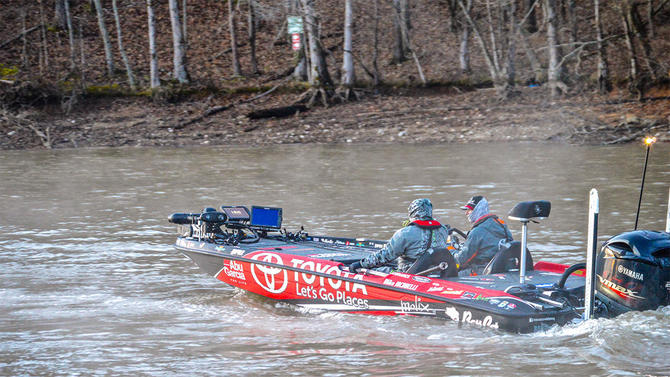
Photo by wired2fish.com
少し諦め気味だったアイコネリでしたが、プラクティス2日目にはジャークベイトのアクションに小さく柔らかいトゥイッチを試してみました。彼はすぐにバスを釣りました。リズムをそれほどアグレッシブにしないことによって、アイコネリはグランドレイクじゅうを走りまわり、最終的には4位に入るほどのジャークベイトパターンを発見することができました。その間、同じトーナメントの同じエリアで、ケビンバンダムはストライクキングのジャークベイトをアグレッシブにジャークして、トップ10に入賞しています。この話の教訓は、魔法のジャークベイトのリズムなどバス釣りにはないということです。
「私はフィールドに出るたび、その日、その瞬間を釣るようにしているので、決まったリズムで自分自身を縛るようなことはしません。」とアイコネリは言います。 「一般的な経験則として、水温が低いほど、ジャークとジャークの間のポーズは長くし、ロッドティップでルアーに与えるジャークもやわらかくします。反対に、暖かい水では、ルアーをより速くより強く動かします。リズムはそのフィールドごとにも変えますし、状況によっては一日の中でさえ変えることがあります!」
最初のバイトを得るまではルアーのリズムやアクションは交互に変えて行きます。バスがどのリズムやアクションに反応したのかに注意を払い、次のキャストでそのアクションをちゃんと再現することに最善を尽くしてください。
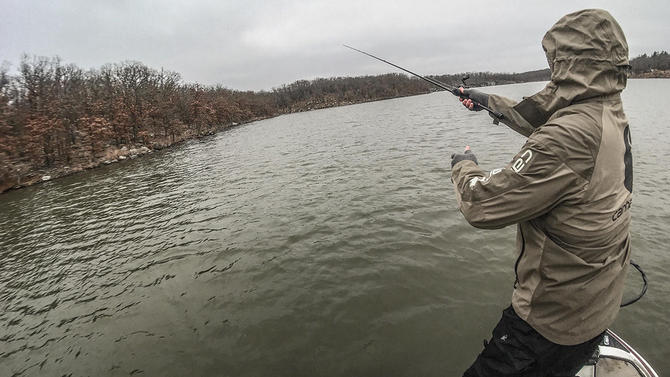
Photo by wired2fish.com
その他の変更について
While varying cadence is key, it’s not the only way to change the action of your jerkbait. Over the years bass anglers have figured out several ways to change the way a jerkbait behaves under water. First things first, don’t be afraid to try different colors, brands and diving depths of jerkbaits. All jerkbaits have slightly different actions and a small change can bring surprising results-especially in clear water.
“The first thing you can do is simply change the type of jerkbait you are using," Iaconelli said. “The Original Rapala Shadow Rap and the Shadow Rap Shad are two jerkbaits that look similar to the naked eye but have very different actions. The Shadow Rap is designed to go nose-down and slowly sink on a pause, while the Shadow Rap Shad will go nose-up and slowly rise when paused. Subtle differences, sure, but they make a huge difference to a coldwater bass."
Changing the line size and type you pair a jerkbait with also modifies how your lure reacts on a retrieve. Ask 10 jerkbait aficionados and you may get 10 different answers on which fishing line is the best to use.
Some anglers swear by fluorocarbon which sinks, has less stretch and helps the bait get down a little deeper; while others employ monofilament which floats and allows a little stretch which many argue gives cold-water bass a better chance of being hooked. All options can work, but understanding how the different lines and sizes affect the action of your lure will help you catch more bass with jerkbaits.
If you still aren’t getting the desired action out of a jerkbait you can use different sizes and styles of hooks, split rings, snap swivels or add suspend dots and wire wraps around your hooks to adjust the buoyancy and movement of your plug. There are as many tweaks and modifications for jerkbaits as any lure in a fisherman’s tackle box, but they all make important changes.
The key is to not be stubborn when fishing a jerkbait this winter. They are one of the best ways to catch bass in cold water and small adjustments make a big difference. Start with varying the cadence on your retrieve regularly and pay attention to the details to help you make further changes to your lure as necessary.
リズムを変えることは重要ですが、それがジャークベイトのアクションを変える唯一の方法ではありません。長年にわたり、バスアングラーたちはジャークベイトの水中でのアクションを変えるいくつかの方法を考え出してきました。まずさまざまな色、メーカー、潜行深度のジャークベイトを試してみることを恐れないでください。すべてのジャークベイトの持つアクションはわずかに異なり、小さな変化であっても特にクリアウォーターではそれが驚くべき結果をもたらす可能性があります。
「最初にできることとすれば、使っているジャークベイトの種類を変更えるだけです」とアイコネリは言います。 「ラパラのシャドウラップとシャドウラップシャッドの2つは、パッと見は同じように見えますが全く別のアクションをするジャークベイトです。シャドウラップは、ポーズを入れると頭下がりのスローシンキングになり、シャドウラップシャッドはポーズを入れると頭上がりで浮くように設計されています。わずかな違いではありますが、低水温下のバスには大きな違いになります。」
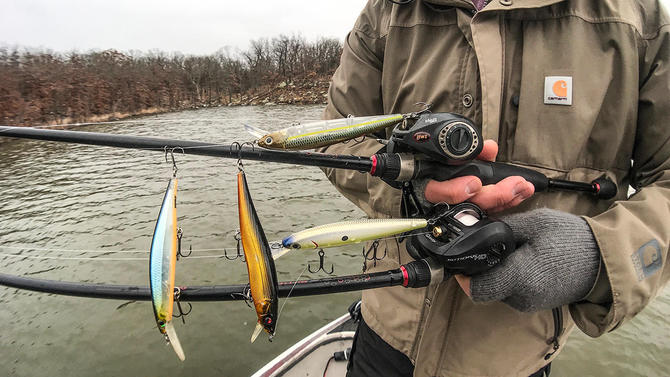
Photo by wired2fish.com
ジャークベイトに使うラインの太さや素材を変更することでも、ルアーをリトリーブしたときの反応が変わります。 10人のジャークベイト愛好家に聞けば、10通りのベストなライン選択の答えが返ってくるかもしれません。
ある人は、沈んで、伸びが少なく、ルアーを深く潜らせるフロロカーボンラインが最高だと言い、またある人は水に浮き、多少の伸びのあるナイロンの方が低水温下でのバイトをフッキングに持ち込みやすいと考えています。これらはすべて正しいということができますが、これはつまりラインの素材と太さの違いがルアーのアクションにどのように影響するかを理解しておくことで、ジャークベイトでより多くのバスを釣ることに役立つ、ということです。
それでもまだジャークベイトで狙ったアクションが得られない場合は、フックやスプリットリング、スナップスイベルを色々なサイズで使ってみたり、フックの周囲に貼り付けオモリや糸オモリを追加して、プラグの浮力と動きを調整することもできます。釣り人のタックルボックスの中にあるルアーと同じくらい、ジャークベイトのチューニングはありますが、それらはすべて重要な影響を与えます。
大事なのは、冬にジャークベイトで釣るときには頑固にならないことです。これは低水温下でバスを釣るための方法の一つで、小さな調整が大きな違いを生みます。まずはいつもの自分のアクションのリズムを変えることから始めて、さらにルアーに役立つ他の変更が必要ないかに注意を払ってください。
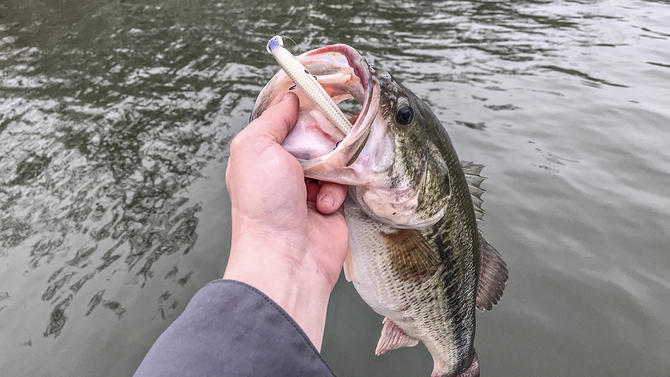
Photo by wired2fish.com
いかがでしたか。
ジャークベイトを扱うにはオープンマインドが必要なんですね。
これでいいんだという決めつけや頑固な性格は冬のジャークベイトにはよろしくないということだそうです。
この記事に書かれていたことで私が大事だなと思ったのは、いいリズムを見つけたらそれを再現する、ということです。
釣れるアクションを見つけたらそれを繰り返せばバイトが再現できるのは当たり前ではあるのですが、ジャークベイトで釣っていると、色んなリズムを試しているだけに、今自分がどんなアクションやどんな巻きスピードで食ってきたかをつい忘れてしまうことがあるのです。
せっかく食ってきたのに、「あれ、今どんなリズムでやってたっけ?」となるのはとてももったいないことなので、ジャークベイトが上手になるコツはアクションがどうというよりも、ちゃんとリズムを意識してアクションさせる、ということなのかもしれません(笑)
ということで、冬のジャークベイトは、決めつけず、変え続け、覚えとく。
やはりプロのアングラー、そしてプロのライターさんが書くと分かりやすいですね…。私なんかより全然伝わってきます。当たり前なんですけど(笑)
ジャークベイトはこれを意識して続けていきたいなと思います。
正解はないということですので、皆さんも自分だけの必殺のリズムを見つけ出してみてはいかがでしょうか。
それではまた。
毎度ありがとうございます!







